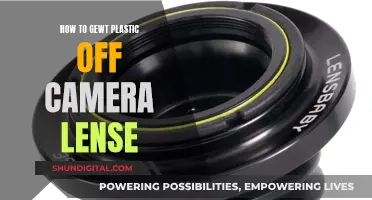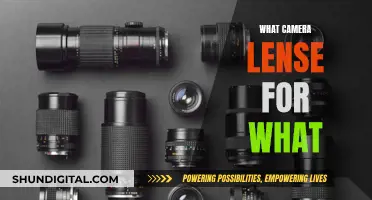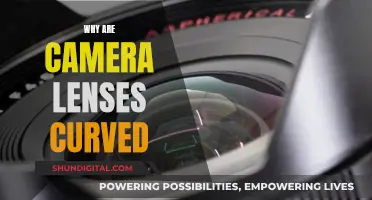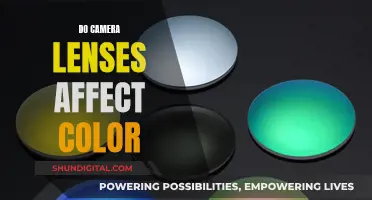
Interchangeable lens cameras are cameras that allow you to swap out the lens to create a camera-lens combination that's perfect for taking the types of photos you want. They are often capable of producing better image quality in a wider range of situations than smartphones can, and give you a lot more control over your photographs.
There are two main types of interchangeable lens cameras: mirrorless cameras and DSLRs.
Mirrorless cameras are digital cameras that, unlike DSLRs, do not use a mirror to ensure that the image presented to the photographer through the viewfinder is identical to that taken by the camera. They are generally smaller, quieter, and lighter than DSLRs. They also tend to be better suited to video capture, so that’s where all the innovation in autofocus is occurring and where the newest/best lenses are appearing.
DSLRs, on the other hand, use a mirror to direct light into an optical viewfinder, letting you preview the scene directly through the lens. They have vast pools of second-hand lenses available and their autofocus systems, which have been developed over decades, can be very good. However, most camera makers are now focused on mirrorless cameras.
When choosing an interchangeable lens camera, it's important to consider the size of the camera's sensor, the types of lenses you'll want in the future, the camera's autofocus system, and whether you want a built-in flash or a hot shoe for attaching an external one.
| Characteristics | Values |
|---|---|
| Camera Type | Mirrorless, DSLR |
| Image Quality | Better than smartphones |
| Sensor Size | Four Thirds, APS-C, Full Frame |
| Battery Life | Longer in DSLRs |
| Autofocus | All focus points across the image in mirrorless, near the center in DSLRs |
| Lenses | Vast range in DSLRs, newer and better lenses in mirrorless |
What You'll Learn

Image quality
Interchangeable lens cameras have larger sensors that can gather more light, which gives cleaner images and they often have higher pixel counts, giving more detail.
The three most common sensor formats are Four Thirds, APS-C and Full Frame. Full frame is more likely to allow you to blur the background of your images, and provide clearer images in low light conditions, but by the time you've bought lenses, it can get quite big and expensive. For travel and hiking or for photography requiring long lenses, the smaller formats offer distinct advantages in terms of price and portability.
Mirrorless cameras, which don't have the mirrors and optical viewfinders found in DSLRs, are increasingly popular. They are generally smaller, better suited to video capture, and that’s where all the innovation in autofocus is occurring and where the newest/best lenses are appearing.
Sony's entry-level full-frame mirrorless α7 II camera has a 24-megapixel 5-axis stabilised sensor, but is more compact and less expensive than any full-frame sensor DSLR.
Do Contact Lenses with Camera Exist?
You may want to see also

Control
Manual Control Over Exposure: Interchangeable lens cameras, often abbreviated as ILCs, allow users to take full manual control over exposure. This means that photographers can manually adjust the aperture, shutter speed, and ISO to achieve their desired results. This level of control is not typically available on smartphones and can be a significant advantage when shooting in challenging lighting conditions or when trying to achieve specific creative effects.
Lens Selection: The ability to swap out lenses is a defining feature of ILCs and offers a tremendous amount of control to photographers. Different lenses provide varied fields of view, allowing for wide-angle, standard, telephoto, or macro perspectives. Additionally, lenses with different maximum apertures provide control over depth of field, bokeh, and low-light performance.
Focus Control: ILCs often feature advanced autofocus systems with numerous focus points spread across the frame. This enables photographers to precisely select their focus areas and ensure their subjects are sharp. Some ILCs also offer manual focus options, providing even more precise control over the plane of focus.
Shooting Modes: Interchangeable lens cameras typically offer a variety of shooting modes that give users control over how the camera captures images. These include fully automatic modes for beginners, as well as semi-automatic modes like aperture priority and shutter priority, which give the photographer control over specific aspects of the exposure. Manual mode provides complete control over all exposure settings.
Post-Processing: ILCs usually capture images in raw format, which offers greater control during post-processing. Raw files contain more data and dynamic range than JPEGs, allowing for more flexibility when editing images. This gives photographers the ability to fine-tune their images and apply various creative effects.
Video Control: Many modern ILCs offer advanced video capabilities, providing control over various aspects of video capture. Users can manually adjust exposure settings, frame rates, and audio levels. Additionally, features like focus peaking and zebras assist in achieving precise focus and correct exposure during video recording.
Camera Lenses: Scratch-Resistant or Not?
You may want to see also

Interchangeable lenses
There are two main types of digital cameras with interchangeable lenses: mirrorless cameras and DSLR (digital single-lens reflex) cameras. Mirrorless cameras are smaller, lighter, and quieter than DSLRs because they do not use a mirror to reflect light from the lens to the viewfinder or image sensor. Instead, the lens always shines light onto the image sensor, and what the camera sees is displayed on a screen for the photographer. This also allows mirrorless cameras to have an electronic viewfinder, which shows the image that will be captured by the camera sensor.
DSLRs can act like mirrorless cameras if they have a "live view" mode, where the mirror moves out of the way so that light always shines onto the image sensor. Many mirrorless cameras still have a mechanical shutter and accept interchangeable lenses.
When choosing an interchangeable lens camera, it is important to consider the sensor size, which affects the image quality and cost of the camera and lenses. Common sensor formats include Four Thirds, APS-C, and Full Frame. Full-frame sensors are larger and tend to provide better image quality and background blur but are more expensive and bulky.
Other factors to consider when choosing an interchangeable lens camera include the viewfinder type (electronic or optical), autofocus system, image stabilization, video capabilities, weather resistance, and flash compatibility. It is also important to research the lenses that are available for each camera system and consider whether the system offers the types of lenses you need at a reasonable price.
Creating Realistic Camera Lenses in Illustrator
You may want to see also

Sensor size
The sensor size of a camera is the physical size of its image sensor, usually measured in mm width x height. A full-frame digital sensor, like those found in the Canon 5D, Sony a7S III, or the Sony Venice, has an area that measures roughly 36x24mm.
The size of a camera's sensor is important because it affects image quality, depth of field, light gathering, ISO performance, field of view, and dynamic range. Larger sensors generally provide better image quality, but smaller sensors have their advantages too. For example, smaller sensors offer a greater depth of field and have a longer hyperfocal distance. They also provide additional reach when shooting subjects from a distance.
Camera sensor size is often expressed as optical format in inches. Some common sensor sizes include:
- Full-frame: 35.00 x 24.00mm
- APS-C: 23.60 x 15.60mm (varies by brand)
- Micro 4/3rds: 17.00 x 13.00mm
- 1": 12.80 x 9.60mm
- 1/2.55": used by the iPhone 11, on the larger end of the spectrum for smartphone sensors
When choosing a camera, it's important to consider your needs as a photographer. If you regularly make large poster prints and want maximum dynamic range and resolution, a full-frame or medium format sensor may be the best choice. If you value size, weight, and performance over large depth of field, a smaller sensor may be a better option.
Q-See Camera Lenses: Plastic or Glass?
You may want to see also

Autofocus
Most modern SLR cameras use through-the-lens optical sensors, with a separate sensor array providing light metering. Through-the-lens optical autofocusing is usually faster and more precise than manual focus with an ordinary viewfinder, although more precise manual focus can be achieved with special accessories such as focusing magnifiers.
The speed of the AF system depends on the widest aperture offered by the lens at the current focal length. F-stops of around f/2 to f/2.8 are generally considered best for focusing speed and accuracy. Most consumer camera systems will only autofocus reliably with lenses that have a widest aperture of at least f/5.6, while professional models can often cope with a widest aperture of f/8.
The data collected from AF sensors is used to control an electromechanical system that adjusts the focus of the optical system. A variation of autofocus is an electronic rangefinder, in which focus data is provided to the operator, but the adjustment of the optical system is still performed manually.
Active AF systems measure distance to the subject independently of the optical system and subsequently adjust the optical system for the correct focus. Passive AF systems, on the other hand, determine the correct focus by performing passive analysis of the image entering the optical system. They generally do not direct any energy, such as ultrasonic sound or infrared light waves, toward the subject.
A hybrid autofocus system combines two or more methods, such as active and passive methods or phase detection and contrast measurement, to increase overall reliability, accuracy, or speed.
When it comes to camera lenses, autofocus capabilities can be limited when using adapters to fit lenses from one brand onto a camera body from another. For example, when using a Canon lens on a Nikon camera with an adapter, autofocus might be slower or not work at all, and you may need to adjust settings manually.
Lenses for Full-Frame Cameras: What's the Difference?
You may want to see also
Frequently asked questions
An interchangeable lens camera is a camera that allows you to change the lens to suit your needs. This gives you more creative control over your photography and can be a great way to improve your image quality.
Interchangeable lens cameras offer better image quality and more creative control than smartphones. They also give you the ability to switch lenses, so you can create a setup that's perfect for the types of photos you want to take.
There are two main types of interchangeable lens cameras: mirrorless cameras and DSLR (digital single-lens reflex) cameras. Mirrorless cameras are generally smaller, better suited to video capture, and more popular with camera manufacturers, whereas DSLRs offer an optical viewfinder and a longer battery life.
When buying an interchangeable lens camera, you should consider the sensor size, lens mount, autofocus system, image stabilization, video capabilities, weather resistance, and flash compatibility. You should also think about whether you want a mirrorless or DSLR camera, and whether the camera has the lenses you need.







